
In the 6th century BC, while Rome was still a minor city-state in the Italian peninsula, the ancient city of Cyrene flourished as one of the wealthiest places on Earth. Nestled on the North African coast in what is now Libya, Cyrene owed its prosperity not to gold or conquest, but to a wild herb that grew abundantly on its plains.
This herb, known as silphium, was so revered that it became a cornerstone of ancient medicine, cuisine, and even romance. It was supposed to treat everything from fevers to marital affairs. According to ancient sources, silphium not only had aphrodisiac properties but also was supposed to prevent pregnancies, making it one of the earliest contraceptives in history.
But its very popularity may have sealed its doom, making silphium one of the earliest documented casualties of human exploitation.
Silphium: ‘the most precious gift from nature’
Silphium plants, also known to the Greeks as laserwort or laserpithecum, were giant fennels that grew wild along the dry hillsides of the Mediterranean coast. It didn’t take long before the Greek settlers who founded Cyrene discovered the herb’s value. Ancient texts describe it as a cure-all, capable of treating everything from sore throats to snake bites. Over time, people learned to make an extract out of the plant’s stems and roots.
Pliny the Elder, the Roman 1st-century AD author, naturalist, and natural philosopher, called this extract “among the most precious gifts presented to us by Nature.” In his Natural History, Pliny cites Theophrastus, an ancient Greek writer widely regarded as the father of botany, claiming that the plant was first discovered after a “black rain” showered down on the Gardens of the Hesperides in Cyrene in the year 136 of the Roman calendar (or 617 BC).
The ancient Roman scholar notes that silphium “grows luxuriantly as an obstinate weed”, most profusely in a region of Cyrene known as Silphiofera, near the Gulf of Syrtis.
According to Theophrastus, silphium closely resembled ferula, a group of plants today known as ‘giant fennels’. Indeed, there’s a resemblance between modern giant fennels and crude illustrations of silphium that have survived on some Cyrene coins.

The stems were roasted, the roots eaten with vinegar, while the precious sap of silphium, known as laser, was grated over foods. Laser quickly became the most expensive and sought-after condiment in the ancient world.
Anecdotic reports from the ancient world suggest that silphium resin was used to treat coughs, sore throat, indigestion, sore throat, warts, and even snake bites and epilepsy. Pliny writes that even bites from feral dogs could be treated by simply rubbing the affected area with the wonder plant, a panacea for every conceivable ailment. Well, almost. Pliny also cautions never to apply silphium to a tooth cavity.
But most of all, silphium resin was cherished as the perfect love potion due to its combo of aphrodisiac and birth control properties. Roman bard Catullus immortalized silphium in one of his love poems, writing in a line that he would share as many kisses with his beloved “as the number of Libyan sands that lie in silphium-bearing Cyrene.”
Soranus, the foremost Roman gynecologist of his time, wrote in surviving text that women looking to prevent conception or “destroy any already existing” should take a chick-pea-sized dose of silphium. Besides this oral contraception method, Soranus also lists an alternative method that involves inserting a tuft of wool soaked in silphium juice into the vagina.
These descriptions are striking because they seem to document the very first instance of birth control.
The love plant that may have given us the ‘I heart you’ symbol
With such a wide appeal, the fame of silphium quickly spread across the Mediterranean, skyrocketing the price of this fennel. By some accounts, the demand was so great that silphium seeds were worth their weight in gold. The great Julis Caesar himself is said to have hoarded a cache of nearly 1,500 pounds (700 kg) of silphium in the official treasury.
Cyrene’s prosperity was so tied to the miracle herb that the local government started stamping coins with silphium seeds or fruit, which have a characteristic ❤️️ shape. This has led some historians to speculate that the “heart” symbol — widely used as a metaphor for love, courage, or fortitude from the Middle Ages to today’s emoji-rich world — may actually represent the shape of silphium seeds.

Another type of minted Cyrenian coin shows a seated woman with a silphium plant at her feet, with one hand touching the plant and the other pointing to her crotch. This coin further cements silphium’s major role in Cyrene’s economy and its citizens’ reproductive health.
The Price of Popularity
Silphium’s popularity would eventually be the end of it. Although Cyrene instituted strict rules to prevent over-harvesting, the huge value of the herb was likely too tempting for most. Cyrene was conquered by Rome in 74 BCE, which likely sped up the impending ecological disaster as wealthy citizens across the republic demanded their love herb at any cost. Local Roman governors and merchants were more than happy to oblige. But short-term profits gave way to permanent extinction.
In time, the supply of silphium dwindled, compounded by the fact that the plant proved impossible to cultivate by human hand. Even today with modern botany knowledge at our disposal, certain wild plants remain stubborn when moved out of their natural habitat and simply refuse to yield to agriculture.
By the end of the 1st century AD, Pliny the Elder decried the treasured plant’s extinction, one of the earliest documented examples of a species’ downfall at the hand of human activity. According to Pliny, during his lifetime he could only confirm the existence of a single stalk of silphium, which was rather unwisely plucked and sent to Emperor Nero.
Besides overharvesting, silphium’s fate may have been sealed by the growing number of grazing animals in the plant’s habitat. Roman landlords would fence off extensive meadows where the herb grew to stop local sheep from devouring the plants, but in time this led to conflicts with the local shepherds. The fences were raised and destroyed by subsequent rebellions.
Attacked from all sides, silphium proved no match for human greed.
Whether or not silphium actually worked and wasn’t just some old wives’ healing remedy will likely never be known, but there are some indications silphium extracts weren’t just hype. Asafoetida and Ferula jaeschikaena, both likely close modern relatives of silphium, cause significantly reduced fertility in mice, a study found. In fact, doctors often urge pregnant women to stay away from these plants due to the significant risk of miscarriage.
Indeed, the pungent-smelling asafoetida, now a popular spice in India and Central Asia, was regarded by the Romans as a second-class, albeit reasonable substitute for silphium.
Today, silphium serves as a cautionary tale for what’s to come. Most people worldwide, including 80% of all Africans, rely on herbal medicine obtained from wild plants — a third of which are now threatened with extinction due to over-harvesting and habitat loss as a result of the expansion of industries, housing, and other human activities.
Silphium’s demise serves as a cautionary tale, urging us to balance our needs with the preservation of the ecosystems that sustain us.



